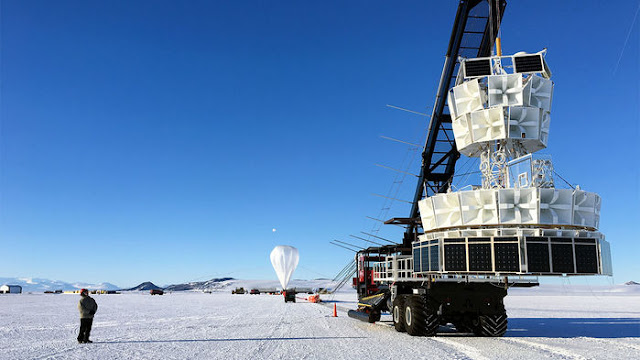Strange particles being emitted from deep within the Antarctica ice.
(The Antarctic Impulsive Transient Antenna (ANITA). Image NASA)
This is an interesting discovery via the Antarctic Impulsive Transient Antenna (ANITA).
From the Standard Model of particle physics, with all coralating particles with their associated antiparticles, that, with the assistance of the Large Hadron Collider in Switzerland - it has been now determined within the SM chart, particles and their antiparticles (counterparts) behave in predictable patterns. Yet, since the discovery of a new particle five years ago called the Higgs Boson, there has been no new or exotic particles detected via the LHC detector. The theories of other particles (supersymmetry) operating within and outside out the Standard Model persist as a possibility, yet are allusive in detection.
In March 2016 NASA's Antarctic Impulsive Transient Antenna, which is a high altitude balloon with sophisticated detection equipment, designed to monitor the Neutrino (a decayed particle of the Neutron, able to pass through matter), although a proven and detected particle, the Neutrino also holds degrees of mystery. Often referred to as the ghost particle. However, what ANITA found was something far stranger, with most detention for cosmic rays sourced from Space which bombard the Earth, with only the LHC recreating high energy particle experiments as a based research. This new particle, which does not fit the Standard Model, emitted itself from beneath the Earth, more specifically from deep within the ice of Antarctica. The Neutrino is a low energy particle, hence its ghostly presence when discovery as interacts with matter once it passes though the Earth (leaving only brief decayed electron traces). What is new and someways a shocking discovery, is that a high energy particle has moved through the Earth (from an unknown source) to expel its self from the other side. It had not directly come from Space.
From Scientific American:
"...physicists have proposed all sorts of explanations for these “upward going” cosmic rays, from sterile neutrinos (neutrinos that rarely ever bang into matter) to “atypical dark matter distributions inside the Earth,” referencing the mysterious form of matter that doesn’t interact with light [The 18 Biggest Unsolved Mysteries in Physics] All the explanations were intriguing, and suggested that ANITA might have detected a particle not accounted for in the Standard Model. But none of the explanations demonstrated conclusively that something more ordinary couldn’t have caused the signal at ANITA..."
A redefining of particle physics:
"...Derek Fox, the lead author on the new paper, said that he first came across the ANITA events in May 2018, in one of the earlier papers attempting to explain them. “I was like, ’Well this model doesn’t make much sense,’” Fox told Live Science, “but the [ANITA] result is very intriguing, so I started checking up on it. I started talking to my office neighbor Steinn Sigurdsson [the second author on the paper, who is also at Penn State] about whether maybe we could gin up some more plausible explanations than the papers that have been published to date.” Fox, Sigurdsson and their colleagues started looking for similar events in data collected by other detectors. When they came across possible upward-going events in IceCube data, he said, he realized that he might have come across something really game-changing for physics. “That’s what really got me going, and looking at the ANITA events with the utmost seriousness,” he said, later adding, “This is what physicists live for. Breaking models, setting new constraints [on reality], learning things about the universe we didn’t know.” As Live Science has previously reported, experimental, high-energy particle physics has been at a standstill for the last several years. When the 17-mile (27 kilometers), $10 billion Large Hadron Collider (LHC) was completed on the border between France and Switzerland in 2009, scientists thought it would unlock the mysteries of supersymmetry—the mysterious, theoretical class of particles that scientists suspect might exist outside of current physics, but had never detected. According to supersymmetry, every existing particle in the Standard Model has a supersymmetric partner. Researchers suspect these partners exist because the masses of known particles are out of wack—not symmetric with one another."
___
Or, could this unknown particle be the wandering 'ghosts' of last remaining imprints of an extinct, yet highly advanced alien civilization?
My 2017 science fiction book CATACLYSMAL (on Amazon) looks at the discovery of mysteries particles that hold messages and insight into what the Universe actually is and what it will become.


Comments
Post a Comment